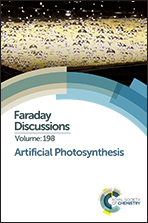13C-Labeling the carbon-fixation pathway of a highly efficient artificial photosynthetic system
Abstract
Interfacing the CO2-fixing microorganism, Ralstonia eutropha, to the energy derived from hydrogen produced by water splitting is a viable approach to achieving renewable CO2 reduction at high efficiencies. We employ 13C-labeling to report on the nature of CO2 reduction in the inorganic water splitting|R. eutropha hybrid system. Accumulated biomass in a reactor under a 13C-enriched CO2 atmosphere may be sampled at different time points during CO2 reduction. Converting the sampled biomass into gaseous CO2 allows the 13C/12C ratio to be determined by gas chromatography-mass spectrometry. After 2 hours of inoculation and the initiation of water splitting, the microbes adapted and began to convert CO2 into biomass. The observed time evolution of the 13C/12C ratio in accumulated biomass is consistent with a Monod model for carbon fixation. Carbon dioxide produced by catabolism was found to be minimal. This rapid response of the bacteria to a hydrogen input and to subsequent CO2 reduction at high efficiency are beneficial to achieving artificial photosynthesis for the storage of renewable energy.
- This article is part of the themed collection: Artificial Photosynthesis

 Please wait while we load your content...
Please wait while we load your content...